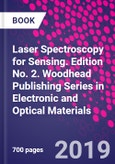Laser Spectroscopy for Sensing: Fundamentals, Techniques and Applications, Second Edition, examines the latest advances in laser spectroscopy and its use in a diverse range of industrial, medical and environmental applications. The book provides an overview of laser spectroscopy at three levels, including the fundamental aspects to consider when planning use of laser spectroscopy to solve a problem (from the sample properties to the laser properties to the data analysis), the technical aspects of several spectroscopic techniques, and the fields of applications of such techniques. New sections include key advancements from the field and chapters surrounding Raman Spectroscopy and Laser-induced breakdown spectroscopy.
- Presents the fundamentals of laser technology for controlling the spectral and temporal aspects of laser excitation
- Explores laser spectroscopy techniques, including Raman Spectroscopy and Laser-Induced Breakdown Spectroscopy
- Considers the spectroscopic analysis of industrial materials and their applications in nuclear research and industry
Table of Contents
Part I: Fundamentals of laser spectroscopy for sensing 1. Fundamentals of optical spectroscopy 2. Lasers used for spectroscopy: fundamentals of spectral and temporal control 3. Fundamentals of spectral detection 4. Using databases for data analysis in laser spectroscopy 5. Multivariate analysis, chemometrics, and machine learning in laser spectroscopy
Part II: Laser spectroscopy techniques 6. Cavity-based absorption spectroscopy techniques 7. Photo-acoustic spectroscopy 8. Laser-induced fluorescence spectroscopy (LIF) 9. Laser-induced phosphorescence spectroscopy: development and application of thermographic phosphors (TP) for thermometry in combustion environments 10. Lidar (light detection and ranging) 11. Photothermal spectroscopy 12. Terahertz (THz) spectroscopy 13. Raman spectroscopy 14. Laser-induced breakdown spectroscopy (LIBS)
Part III: Applications of laser spectroscopy and sensing 13. Laser spectroscopy for the detection of chemical, biological and explosive threats 14. Laser spectroscopy for medical applications 15. Applications of laser spectroscopy in forensic science 16. Application of laser-induced breakdown spectroscopy to the analysis of secondary materials in industrial production 17. Applications of laser spectroscopy in nuclear research and industry 18. Applications of laser spectroscopy in space and environmental applications
Authors
Baudelet, Matthieu Dr. Baudelet is currently the Senior Research Scientist for the Townes Laser Institute at the University of Central Florida (Orlando, FL). His panel covers the fundamentals of laser-induced plasmas, the application of laser spectroscopies such as LIBS, Fluorescence, Raman, FTIR, as fundamental diagnostics as well as sensing techniques for defense, industrial, environmental, biomedical applications and the study of propagation of ultrashort laser pulses for sensing purposes at distances up to the kilometer range.As Assistant Professor of Chemistry in the National Center for Forensic Science at the University of Central Florida, his research focuses on the application of laser-based spectroscopy for forensic analysis: atomic spectroscopy with laser ablation techniques (LIBS and LA-ICP-MS) as well as molecular with Raman spectroscopy. A large part of his research focuses also on the quantification of interferences in spectroscopic signals.








